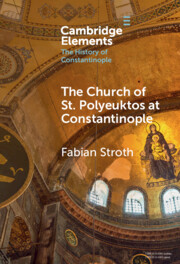34 results
12 - The All-Affected Principle and Climate Change
- from Part III - Taming Economic Power
-
-
- Book:
- Empowering Affected Interests
- Published online:
- 14 November 2024
- Print publication:
- 14 November 2024, pp 211-228
-
- Chapter
-
- You have access
- Open access
- HTML
- Export citation
11 - Women and the Military in the Age of Justinian
-
-
- Book:
- Women and the Army in the Roman Empire
- Published online:
- 24 October 2024
- Print publication:
- 07 November 2024, pp 299-326
-
- Chapter
- Export citation
3 - The Vandal Wars and Conversion in East Roman Africa
-
- Book:
- Conversion and the Contest of Creeds in Early Medieval Christianity
- Published online:
- 06 June 2024
- Print publication:
- 13 June 2024, pp 75-97
-
- Chapter
- Export citation
4 - Nicene–Homoian Conversion in Ostrogothic Italy
-
- Book:
- Conversion and the Contest of Creeds in Early Medieval Christianity
- Published online:
- 06 June 2024
- Print publication:
- 13 June 2024, pp 98-136
-
- Chapter
- Export citation
Chapter 21 - Antioch and the Political Economy of Empire in the Age of Justinian
- from Part III - The People of Antioch
-
-
- Book:
- Antioch on the Orontes
- Published online:
- 06 June 2024
- Print publication:
- 06 June 2024, pp 343-356
-
- Chapter
- Export citation
Chapter 10 - The City Walls of Antioch
- from Part II - The Making of a Capital
-
-
- Book:
- Antioch on the Orontes
- Published online:
- 06 June 2024
- Print publication:
- 06 June 2024, pp 139-163
-
- Chapter
- Export citation
3 - Sex in Constantinople in the Sixth Century ce
-
-
- Book:
- The Cambridge World History of Sexualities
- Published online:
- 26 April 2024
- Print publication:
- 16 May 2024, pp 47-66
-
- Chapter
- Export citation

The Church of St. Polyeuktos at Constantinople
-
- Published online:
- 16 February 2024
- Print publication:
- 21 March 2024
-
- Element
- Export citation

Jews, Christians, and the Discourse on Images before Iconoclasm
-
- Published online:
- 01 February 2024
- Print publication:
- 08 February 2024
32 - The Dissemination and Appropriation of Legal Knowledge in the Age of Justinian
-
-
- Book:
- The Intellectual World of Late Antique Christianity
- Published online:
- 05 October 2023
- Print publication:
- 26 October 2023, pp 608-625
-
- Chapter
- Export citation
Chapter 1 - ‘I Sing of Things That Are Not Unknown’
-
- Book:
- War, Rebellion and Epic in Byzantine North Africa
- Published online:
- 12 October 2023
- Print publication:
- 26 October 2023, pp 1-35
-
- Chapter
- Export citation
1 - Out of Time? Eternity, Christology, and Justinianic Law
-
-
- Book:
- Time, History, and Political Thought
- Published online:
- 08 June 2023
- Print publication:
- 22 June 2023, pp 36-53
-
- Chapter
- Export citation
Chapter 4 - The Dispersal and Decline of the Eastern Field Armies (506–630)
-
- Book:
- The Field Armies of the East Roman Empire, 361–630
- Published online:
- 27 April 2023
- Print publication:
- 11 May 2023, pp 67-91
-
- Chapter
- Export citation

The Field Armies of the East Roman Empire, 361–630
-
- Published online:
- 27 April 2023
- Print publication:
- 11 May 2023
5 - Roman Law, Authority, and Creative Citation
- from Part II - Political and Intellectual Tensions
-
- Book:
- Vernacular Law
- Published online:
- 27 October 2022
- Print publication:
- 03 November 2022, pp 189-230
-
- Chapter
- Export citation
25 - Climate, Environment, and Resources
- from Empirical Approaches
-
-
- Book:
- The Cambridge Companion to the Ancient Greek Economy
- Published online:
- 21 July 2022
- Print publication:
- 04 August 2022, pp 373-391
-
- Chapter
- Export citation
13 - Roman Law: Symbiotic Companion and Servant of Canon Law
- from Part II - The Sources and Dissemination of Medieval Canon Law
-
-
- Book:
- The Cambridge History of Medieval Canon Law
- Published online:
- 13 January 2022
- Print publication:
- 27 January 2022, pp 230-261
-
- Chapter
- Export citation
12 - Rights (II)
- from Part II - Concepts
-
-
- Book:
- The Cambridge Companion to Hugo Grotius
- Published online:
- 03 September 2021
- Print publication:
- 16 September 2021, pp 259-274
-
- Chapter
- Export citation
11 - Rights (I)
- from Part II - Concepts
-
-
- Book:
- The Cambridge Companion to Hugo Grotius
- Published online:
- 03 September 2021
- Print publication:
- 16 September 2021, pp 243-258
-
- Chapter
- Export citation
6 - The Fall of Ostrogothic Rome and the Justinianic Reconstruction
-
- Book:
- The Falls of Rome
- Published online:
- 04 September 2021
- Print publication:
- 09 September 2021, pp 243-299
-
- Chapter
- Export citation

